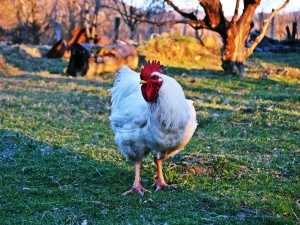
A change in how your bird looks is not always a bad sign, but unfortunately, it can sometimes be, this is why it is important to know why your bird’s appearance is changing.
This article looks into why your chickens face is white
Table of Contents
Why is my chicken’s face white?
The skin on your chicken’s face usually ranges from pink to bright red so seeing your bird’s face change color to white would be alarming.
Here is why this may be happening to your bird:
A parasitic infection:
One reason why your bird may develop a pale face may be that it is infested with parasites.
Parasitic infections can cause your bird to develop anemia, and one of the signs of anemia is a pale face, wattle, and comb. This may be what is going on with your bird.
If your chicken is suffering from anemia then it was likely infected with external parasites like mites or lice. These parasites feed on your bird’s blood causing anemia.
Signs of infection include the bird being tired because of the loss of blood as well as excessive scratching, birds do this because the parasite bites irritate the bird’s skin
What to do:
Test this theory out by checking to see if your bird has parasites. The parasites will usually collect on the skin around the bird’s vent.
If you think that your bird is suffering from a parasitic infection then a trip to the vet is in order.
The vet will be able to examine your bird and prescribe treatments that will get rid of your bird’s specific parasite.
These parasites are usually treated with poultry dust, the bird’s hen houses also need to be treated with poultry dust as well.
Favus:
Another reason why your bird’s face may be turning white is that the bird has favus. Favus develops when your bird’s skin is invaded by fungi.
This condition causes your bird to develop small white spots on the non-feathery parts of its body and these small white spots will turn into large powdery white spots over time.
Favus starts off affecting the non-feathery parts of your bird’s body, like the bird’s face, but it can also affect the bird’s comb, legs, and wattles.
After the white spot stage, your bird’s spots will scab off leaving what looks like a wrinkled crust on your bird’s skin.
If this condition spreads to the feathered parts of your bird then this can cause the feathers to fall out and crusty skin to develop around your bird’s feather follicles.
What to do:
If you think that your bird has favus then taking the bird to the vet is recommended.
The vet will remove the crusts off of your bird’s skin and apply antifungal medication to the infected areas. Antifungal treatments that the vet may use include miconazole or miconazole nitrate.
If your bird has a mild case of favus then the bird may recover without being given any treatment, but more severe cases may need treatment.
Be sure to isolate the sick bird to keep it from infecting any of your other birds in the flock.
If you enjoyed this article then you may also be interested in other bird related articles. Here are some articles that you may be interested in: Why Is My Chickens Skin Green?, Why Is My Chicken’s Skin Yellow?, Chicken Has Lump Under Eye, Chicken Swollen Under Beak, Why Is My Chicken’s Skin Red?, Red Skin On Chicken Head, Why Is My Chickens Face Red?, Why Does My Chickens Face Change Color?, Chicken Pale Around Eyes

